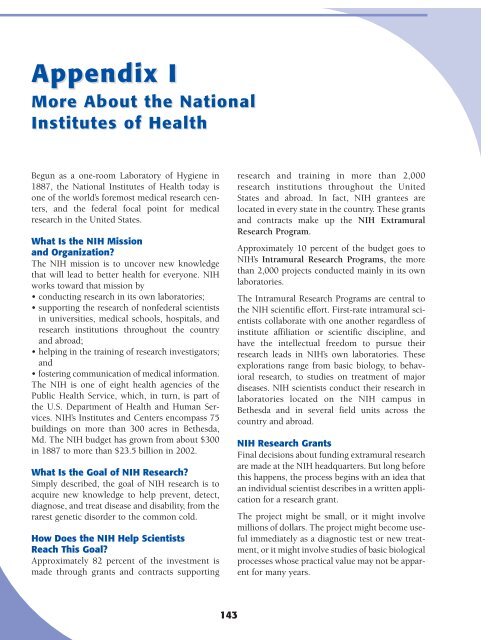Biological - NIH Office of Science Education - National Institutes of ...
Biological - NIH Office of Science Education - National Institutes of ...
Biological - NIH Office of Science Education - National Institutes of ...
Create successful ePaper yourself
Turn your PDF publications into a flip-book with our unique Google optimized e-Paper software.
Appendix I<br />
More About the <strong>National</strong><br />
<strong>Institutes</strong> <strong>of</strong> Health<br />
Begun as a one-room Laboratory <strong>of</strong> Hygiene in<br />
1887, the <strong>National</strong> <strong>Institutes</strong> <strong>of</strong> Health today is<br />
one <strong>of</strong> the world’s foremost medical research centers,<br />
and the federal focal point for medical<br />
research in the United States.<br />
What Is the <strong>NIH</strong> Mission<br />
and Organization?<br />
The <strong>NIH</strong> mission is to uncover new knowledge<br />
that will lead to better health for everyone. <strong>NIH</strong><br />
works toward that mission by<br />
• conducting research in its own laboratories;<br />
• supporting the research <strong>of</strong> nonfederal scientists<br />
in universities, medical schools, hospitals, and<br />
research institutions throughout the country<br />
and abroad;<br />
• helping in the training <strong>of</strong> research investigators;<br />
and<br />
• fostering communication <strong>of</strong> medical information.<br />
The <strong>NIH</strong> is one <strong>of</strong> eight health agencies <strong>of</strong> the<br />
Public Health Service, which, in turn, is part <strong>of</strong><br />
the U.S. Department <strong>of</strong> Health and Human Services.<br />
<strong>NIH</strong>’s <strong>Institutes</strong> and Centers encompass 75<br />
buildings on more than 300 acres in Bethesda,<br />
Md. The <strong>NIH</strong> budget has grown from about $300<br />
in 1887 to more than $23.5 billion in 2002.<br />
What Is the Goal <strong>of</strong> <strong>NIH</strong> Research?<br />
Simply described, the goal <strong>of</strong> <strong>NIH</strong> research is to<br />
acquire new knowledge to help prevent, detect,<br />
diagnose, and treat disease and disability, from the<br />
rarest genetic disorder to the common cold.<br />
How Does the <strong>NIH</strong> Help Scientists<br />
Reach This Goal?<br />
Approximately 82 percent <strong>of</strong> the investment is<br />
made through grants and contracts supporting<br />
research and training in more than 2,000<br />
research institutions throughout the United<br />
States and abroad. In fact, <strong>NIH</strong> grantees are<br />
located in every state in the country. These grants<br />
and contracts make up the <strong>NIH</strong> Extramural<br />
Research Program.<br />
Approximately 10 percent <strong>of</strong> the budget goes to<br />
<strong>NIH</strong>’s Intramural Research Programs, the more<br />
than 2,000 projects conducted mainly in its own<br />
laboratories.<br />
The Intramural Research Programs are central to<br />
the <strong>NIH</strong> scientific effort. First-rate intramural scientists<br />
collaborate with one another regardless <strong>of</strong><br />
institute affiliation or scientific discipline, and<br />
have the intellectual freedom to pursue their<br />
research leads in <strong>NIH</strong>’s own laboratories. These<br />
explorations range from basic biology, to behavioral<br />
research, to studies on treatment <strong>of</strong> major<br />
diseases. <strong>NIH</strong> scientists conduct their research in<br />
laboratories located on the <strong>NIH</strong> campus in<br />
Bethesda and in several field units across the<br />
country and abroad.<br />
<strong>NIH</strong> Research Grants<br />
Final decisions about funding extramural research<br />
are made at the <strong>NIH</strong> headquarters. But long before<br />
this happens, the process begins with an idea that<br />
an individual scientist describes in a written application<br />
for a research grant.<br />
The project might be small, or it might involve<br />
millions <strong>of</strong> dollars. The project might become useful<br />
immediately as a diagnostic test or new treatment,<br />
or it might involve studies <strong>of</strong> basic biological<br />
processes whose practical value may not be apparent<br />
for many years.<br />
143

















